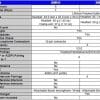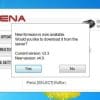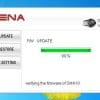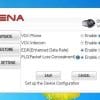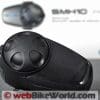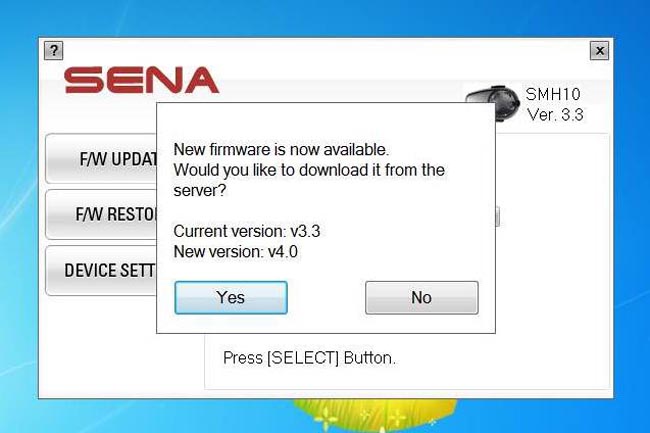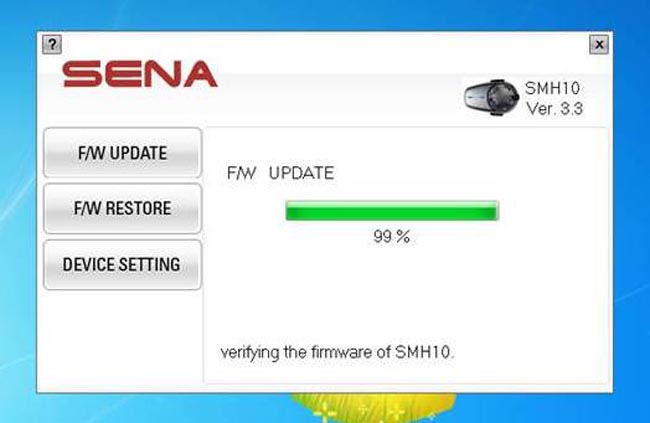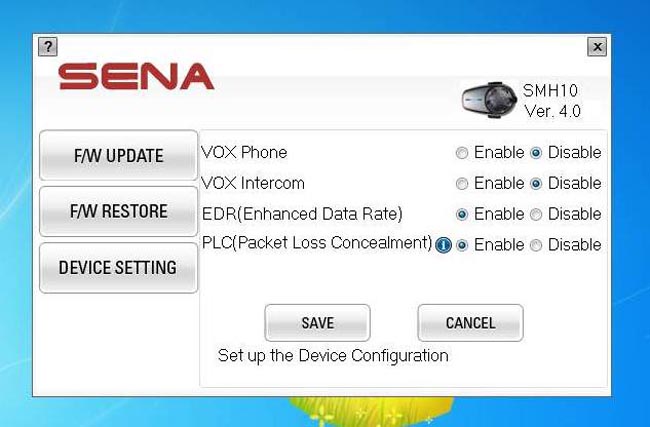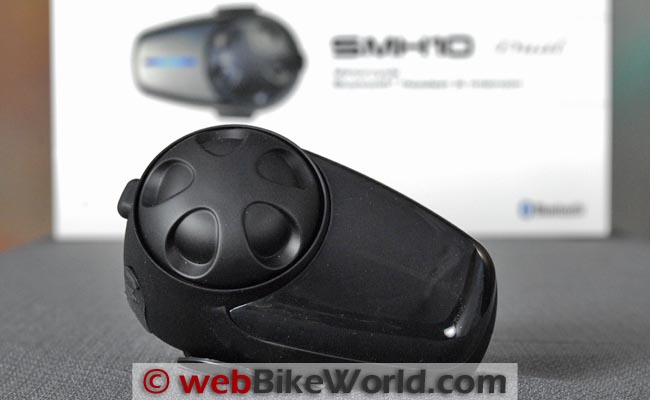NEW! Part 2: Tips, tricks, installation and many rider comments added below.
The Sena SMH10 intercom firmware 4.0 update is now available!
Also, Sena released an Apple Macintosh compatible version of their updating software, available here for registered SMH10 owners.
To obtain the updating software for either a PC or Mac, you must first register your SMH10 with the serial number on the back of the intercom module, then log in with your email address.
We’re in the process of updating our SMH10 intercoms and will report back as soon as we can evaluate the new system.
In the meantime, be sure to read the Owner Comments section below for feedback from Sena SMH10 intercom owners on the new V4 firmware update.
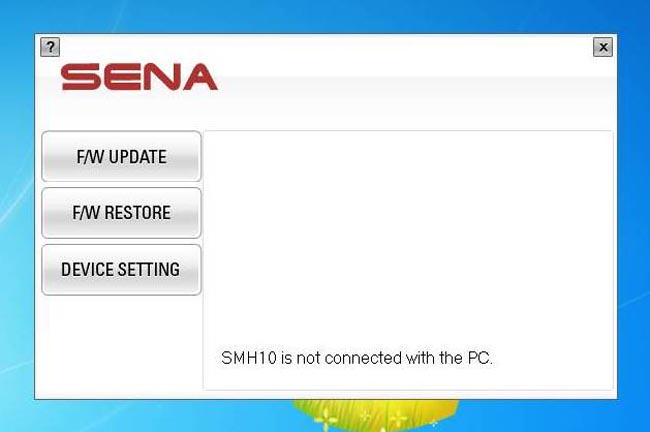
SMH10 Version 4 Firmware Upgrade Notes
SMH10 owners must first register at the link above, then the firmware updater software (for PC or Mac) can be downloaded. Follow the instructions carefully. Here are the firmware updating instructions (.pdf).
Note also that when the intercom module is first connected via the USB port to the computer, it may take some time for the device driver to load and configure. If you connect the intercom via the USB port and the firmware updater software doesn’t recognize it, wait until the device driver loads and you get a successful installation message (usually from a system icon notice in the taskbar on a PC).
Background
Sena said that regular firmware updates are planned and will be a part of the continuing evolution of the SMH10 intercom (current firmware update is 3.3).
Firmware updates will provide functional enhancements for both the SMH5 (preview) and SMH10 (review) communication systems for features such as group communication, GPS and other device support.
The 4.0 firmware update for the Sena SMH10 will provide major new enhancements to the system, including:
Bluetooth v3.0: The 4.0 firmware will upgrade Sena SMH10 intercoms from Bluetooth 2.1 to Bluetooth 3.0. This provides enhanced radio power management (i.e., longer battery life) and higher data transfer rates. Users will experience enhanced performance of the SMH10 and line-of-sight communication distance of up to 900 meters.
Four-way Conference Intercom Function: The 4.0 firmware upgrade will allow four-way conferencing on Sena SMH10 systems.
Multi-point Support: GPS pairing is provided to enable users to connect to a GPS (or a Sena SR10 (review)) at the same time with the phone connection. Technically, users can attach another HFP (Hands-Free Audio Profile) audio stream overlaid to the existing HFP, which might be a phone call.
Voice Prompts: The firmware 4.0 update will provide a new voice prompt functionality in the SMH10. Voice prompts are spoken automatically in the speakers to guide the user in making choices and understanding what’s happening during headset use. It will also provide utility functions, such as a battery level check and more. (Note: Sena has has voice control and Siri since firmware update 3.3).
UPDATE (February 27, 2012) – Sena also announced that new release manager software compatible with Mac OS X will be ready along with the v4.0 firmware release.
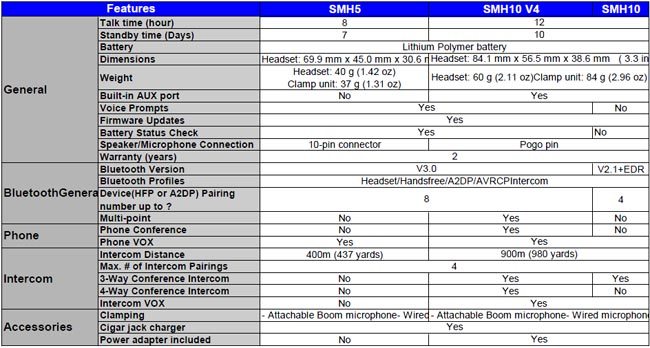
Sena SMH10 Firmware 4.0 Update: The Straight Scoop
April 12, 2012 – It is said that patience is a virtue and this same virtue has kept many Sena SMH10 owners patiently waiting for the much anticipated Sena SMH10 4.0 Firmware Update that was finally released 2 April 2012.
Like the Editor, it didn’t take me long to download the Version 4 firmware Release Notes from the Sena website, the SMH10 Manager v1.3 (locally installed software to manage the download and firmware upgrade process) and version 3.0.0 of the User’s Guide.
I then configured the software on my desktop PC and Sony VAIO notebook running MS Windows 7 Professional, along with an ASUS Slate tablet running Windows 7 Home Premium that is my preferred mobile computing travel companion.
So in the midst of working on other webBikeWorld Bluetooth system evaluations and some accessory reviews, the Editor asked if I could squeeze in a priority effort on this firmware release. He knows I have four of the SMH10 systems on hand, a whole bunch of peripherals to use and lots of riding opportunities.
The opportunity was not to be ignored, so what follows is an expansion of the initial webBikeWorld posting with findings, thoughts and impressions in working through this major firmware release from Sena for the SMH10 systems.
Sena SMH10 Manager Software
A key component not to be overlooked in the Sena SMH10 Version 4 firmware release is the SMH10 Manager Software application, version 1.3 (also released 2 April 2012). It is available for Windows XP, Windows 7 (32 and 64 bit) and now Mac OS X (Snow Leopard 10.6 and Lion 10.7).
The Microsoft Windows versions of this latest software seems stable; I have used it successfully on all the Windows platforms supported, with the only issue encountered being an outdated patch for the compiler on the XP platform. Once this was updated, everything worked fine.
I cannot stress strongly enough how important it is to install and download the latest manager software and make sure necessary drivers or OS patches are installed if errors are noted and don’t hesitate to seek direct support from the manufacturer or other users — directly or using on-line resources.
Some owners have reported issues (see the Owner Comments section below), mainly with the Mac OS versions and MS Vista platforms. It should be noted also that Sena does not list, nor support, the Vista platform.
But it hasn’t taken Sena long to respond and step up to the plate to provide assistance to the Mac OS users, with some of the latest feedback postings indicating resolution of issues; all good and kudos to Sena.
General installation and use of the latest SMH10 Manager software is straightforward and well detailed in the v1.3 SMH10 Manager .pdf document. There is even a driver workaround or troubleshooting section.
One thing to note is that when doing multiple or subsequent system updates, like for a pair or the four I have on hand, the firmware only needs to be downloaded once. Once it is stored on the computer or some form of media, subsequent updates can be done by just accessing the firmware file (detailed in Section 2.4 of the SMH10 Manager manual).
Unless a different path is specified during the download process, the default path is to the Sena Technologies/SMH10 Manager/IMG folder (this will vary by OS of course). If the application doesn’t remember the previous download and asks if you want to download the firmware again, just select “No” on the download update screen to bring up the “Select” screen.
Clicking on “Select” takes you to the default download folder; highlight the v4.0 file and click “Open” to load the path into the application. When the Update prompt appears, click on “Update” to start. The process takes one to two minutes with another 30 seconds or so of the “Progress” alert flashing as the firmware upload is verified.
A minor timeout of ten seconds may occur before the yellow highlight prompt appears, asking you to push the Phone and Jog Dial buttons on the intercom module simultaneously until the prompt disappears. The firmware notification in the upper right corner of the application screen then changes from v3.3 to v4.0.
From this point you can update another system or exit the program and use the devices. Don’t forget that with new firmware, the device is set to a factory default state…
New in Version 4: SMH10 Voice Prompts
With all four devices updated to the new firmware it is time get started by cranking up one of the SMH10s. Turning the device on as usual will bring about the standard set of welcome tones, but in addition, a cheery “Hello” is heard and if you keep holding the buttons for a further three seconds three high tone beeps will be generated, followed by “the voice” indicating the battery level. Welcome to V4 with voice prompts!
Multipoint Pairing
One of the most welcome new features for the Sena SMH10 provided by the version 4.0 firmware update is multipoint pairing. Although not a feature specifically based on Bluetooth version 3.0, multipoint pairing provides a solution to functional requirements and is a very timely inclusion.
Simply put, multipoint allows two headset/hands-free or HFP profile enabled devices to be connected to and supported by the headset concurrently.
Many of us pair a smart phone to the SMH10 via the Phone button to enable HFP, A2DP and AVRCP services. With multipoint, a second device that only needs to provide headset or hands-free services (HFP) — such as voice navigation instructions from a GPS — can be paired to the SMH10 with both peripherals used simultaneously (technically).
With a new feature comes a new pairing procedure. Turn the system on, press the Jog Dial for five seconds until the Red LED flashes rapidly and a series of beeps is heard. Within two (2) seconds, tap the Phone button. The Blue LED starts flashing and high tone double-beeps are heard, followed by a “Multipoint Pairing” announcement.
Pairing mode on the GPS is now initiated and once the “SMH10 V4.0” is detected and identified on the screen, enter “0000” if so prompted. With pairing confirmed and the SMH10 ready a “Your headset is paired” announcement is heard.
A definite improvement over single-point (instance) profile support, the multipoint capability still has limitations due mainly to system audio priorities which for the SMH10 are: Phone/GPS, Intercom, Wired Audio and, Bluetooth Music streaming, high to low respectively.
With a GPS paired via multipoint for navigation instructions, the intercom can be used although navigation audio still interrupts the session, but the intercom resumes almost immediately after the voice string is ended. Not mixed or background audio, but far better than before.
But with an external hub, like the Sena SR10 Bluetooth Stereo Adapter (review) paired using the multipoint process, the advantages of multipoint are clearly demonstrated; audio from peripherals connected to the SR10 now stream to the headset and mixes with SMH10 audio. Only the highest priority SMH10 audio interrupts the incoming audio. You can concurrently carry on an intercom conversation and listen to the background audio without interruption.
An additional plus is that information gleaned from a background audio source can now be passed along to others in real time via the SMH10 intercom link or two-radio if that medium is in use via the SR10.
Selective Profile Pairing
This is a feature that is going to prove (very) useful to many users, particularly with certain peripherals (like the iPhone 4S) that insists on capturing and holding all functional profiles whether in use or not.
If you only need or want to use the A2DP or HFP profile with a device, the two pairing procedures outlined below will do the trick. Note: Before utilizing this feature it is necessary to clear the current pairing list on the SMH10 and the mobile/smart phone to be used.
There are two basic ways to do this, with the first one being preferred: Using the Configuration Setting Menu “Delete All Pairings” option described on page 17, section 9.5 of the User’s Guide or, more drastically, reset the system to factory default, as described on page 28, section 19 of the User Guide.
A2DP Stereo Music Only
Turn the headset on and press the Phone button on the SMH10 intercom module for five seconds until the Red/Blue LED pattern starts and multiple beeps are heard. Within two (2) seconds tap the Jog Dial again; the LED starts flashing red, double-tone beeps are heard and a “Media selective pairing” announcement is heard. Select the Sena SMH10 V4 device from the Bluetooth device listing on the mobile/smart phone and if needed enter 0000 as the PIN.
Once negotiations are completed, the peripheral device is now connected to the headset for A2DP/AVRCP stereo streaming services only.
Hands-Free (HFP) Only
The procedure for setting up a hands-free only connection is the same as for A2DP stereo music only, but in this instance it is the Phone button that gets tapped again within two seconds of activating the Red/Blue LED sequence.
The LED starts flashing blue, double-beep tones are heard and a “Phone selective pairing” announcement is heard. Select the SMH10 V4 device on the mobile/smart phone, entering 0000 if needed and wait for negotiations to be completed; the peripheral is now connected with the headset for two-way hands-free (mono) services only.
So to recap: for selective A2DP music services, the Phone and Jog Dial on the SMH10 intercom module are used to initiate and complete the process; for hands-free pairing only, the Phone button is used to both initiate and complete the process. I tried both selective pairing options with a number of mobile/smart phones and everything worked as claimed…including my iPhone 4S.
Intercom Conferencing
Four SMH10 systems can be paired by separate pairings and accessed via 1, 2 or 3 taps of the Jog Dial for discrete one-on-one sessions. Earlier firmware versions also provided a true three-way intercom conferencing by allowing two simultaneous intercom connections.
With version 4.0, an additional configuration now allows a fourth to join a conference, albeit in a manner that still respects the pairing fundamental.
The new participant in the conference is added by “D” making an intercom call to “C”. Once accepted, “D” now becomes the fourth member of the conference. The limitation here is that “D” can only link in via “C” for conferencing.
So just before I unexpectedly lost one of my Sena SMH10 systems due to (another) interface pin failure, the three and four way conference sessions were successfully conducted, albeit brief in nature.
As long as the basic connection rules are followed; e.g. A to B, C to A and D to C, getting three, and then four users into a common forum is pretty simple.
Exiting is just as easy — individually or in pairs. Point to note: as revealed in the Sena model feature table the new SMH5 work in pairs only (up to four can be paired) and does not support three or four-way conferencing, something that needs to be considered in any mixed model configuration.
Conference Phone Calling
Another new feature of SMH10 version 4 firmware update is the ability to bring a previously paired intercom (B, C or D) user into an ongoing mobile phone call (while stopped of course).
Simply tapping the Jog Dial 1, 2 or 3 times brings the desired participant into the (now) three-way conference phone call. Tapping the Jog Dial again disconnects the intercom participant but maintains the phone call, whereas pressing the Jog Dial for two seconds, tapping the Phone button or waiting for the other phone party to hang up ends the call while keeping the intercom session open. It all works.
SMH10 Configuration Setting
With the voice prompt support now installed as part of the version 4 firmware update, working through the more complex V4 configuration menu is pretty simple.
To get to the Voice Configuration Menu, press and hold the Jog Dial for 12 seconds until the LED is solid Blue. High tone double-beeps are heard and the {Configuration menu} announcement is made.
Stepping through the six menu items — VOX Phone, VOX Intercom, Voice Prompt, PLC Setting, Delete All Pairings and Exit Configuration — is done by rotating the Jog Dial clockwise or counter-clockwise, depending on how fast you want to navigate to any specific category.
Each menu item is identified by a voice announcement (prompt) and enabling a feature or executing any command is done by tapping the Phone button; disabling a feature is done by tapping the Jog Dial. The user has ten seconds in which to make a setting choice, with the system reverting to standby after that time if there is no input.
To exit the menu, directly rotate the Jog Dial until a voice announcement, {Exit configuration} is heard, then tap the Phone button. Section 9 of the User’s Guide provides the needed information textually and visually so that users can get the most out of the system via the Configuration Menu.
Sena SMH10 User’s Guide for Firmware V4.0
Version 3.0.0 of the Sena SMH10 User’s Guide reflects the same general care and attention put into the V4 release. Big sections of the manual have been rewritten and layouts modified to provide a very comprehensive and very useful reference publication that is still small enough to carry with you. The tables, diagrams and case studies are by themselves descriptive enough to let most users navigate through the SMH10 successfully.
Sena SMH10 Version 4 Firmware Update Volume Decrease Issue
UPDATE (April 16, 2012) – Sena confirmed that the maximum volume is reduced by approximately 10% after the Version 4 firmware upgrade. This was done to “tune the audio overlay feature in HFP and intercom”, according to Sena. There is no volume difference in A2DP, however. They’re working on the issue and it will be resolved in the next firmware update.
Sena also said they investigated the possibility of developing a Bluetooth-based firmware update software manager but the technology doesn’t support it at this time.
UPDATE (April 22, 2012): webBikeWorld reader “D.H.” (Owner Comments below) has a tip: “Volume is an issue in v4, but there is a possible workaround. For those who experience a dramatic decrease after updating, some have had good luck (me included) with installing the firmware a second time and doing a reset to factory defaults. I use earplugs and after my second go-round the sound is more than adequate.” (Editor’s Note: I asked Sena about this and they said a reinstallation would have no effect. The volume is down about 10% after the upgrade and they’re working on a fix.)
Conclusion
My evaluation of the Sena SMH10 V4 system included static, street-based and riding activities to evaluate the original and new features provided by the system.
I only have one observation in addition to ones made in the respective sections and it regards audio levels; this observation has also been raised by others. I will be deliberately rolling back one of the systems to version 3.3 to see if there actually is a reduction in audio levels between the two versions. Right now it is hard to quantify, but there is a difference.
This is a very subjective assessment of course and hopefully Sena will provide some information to address this issue.
Implementing Bluetooth 3.0, along with companion technologies, keeps moving the performance yardstick along and the market segment moving forward rapidly. Consumers will see continued development and evolution of products as the features of both Bluetooth 3.0 and subsequent versions are exploited, especially if we keep providing constructive timely feedback and exercising our rights as consumers.
Bottom line: Sena continues its roll and if this major firmware release is an indication of what is coming, this ride will be interesting.
But for many loyal users of the original SMH10A (non-USB version), their frustration continues as they are still waiting for the ability to update their systems wirelessly via Bluetooth, a capability that industry would do well to pursue…
See Also: Sena SR10 Bluetooth Stereo Adapter Review
Publication Date: Revised April 13, 2012 (Original Publication Date: February 24, 2012)
Owner Comments and Feedback
See details on submitting comments.
From “D.H.” (April 2012): “I am finding the new firmware (v4) to be just what I need for my setup: zumo 660 and Valentine radar detector hardwired to SR10; SR10 paired via HFP to SMH10; iPhone 4 paired via A2DP and HFP to SMH10.
Note that zumo 660s do not play nice with selective or multiple pairing; they disconnect repeatedly while trying to “hog” both HFP and A2DP slots. That’s why mine is hardwired.
There are a few quirks to be aware of: For Mac users, the updater works best on a laptop (or desktop with wired keyboard and mouse) for the fairly obvious reason that no BT device is needed to control the cursor and enter typed commands. I agree that this is clumsy and hope Sena will come out with better code soon.
For SR10 users, as others have said, it is great to have radar alerts mixed in so other cheapskates — I mean riding buddies — can benefit from my Valentine 1 [grin]. But this will not work if you have a 3- or 4-way intercom conference in progress. This is because the intercom conference essentially shuts down all input from the SR10 until the conference ends, at which time the SR10 usually comes back online automatically. If it does not, a tap on its pairing button will bring it back.
Volume is an issue in v4, but there is a possible workaround. For those who experience a dramatic decrease after updating, some have had good luck (me included) with installing the firmware a second time and doing a reset to factory defaults. I use earplugs and after my second go-round the sound is more than adequate.”
Editor’s Note: I asked Sena about this and they said a reinstallation would have no effect. The volume is down about 10% after the upgrade and they’re working on a fix.
From “R.W.” (April 2012): “The update came out on the day I departed on a month long journey with my partner. After a few days when I had time, I upgraded our units. My unit is connected to a Zumo 665 which in turn was connected to a non-smart phone. The other unit is connected to a dongle which is connected to a Garmin 478 gps unit.
V3.3 worked great for us, allowing music via XM and intercom communication overridden by gps prompts. V4.0 paired easily and connected quickly. No problems were encountered with the dongle/478 pairing.
However, the Zumo 665 has issues. After one GPS prompt while using intercoms I found that it was not returning to the intercom nor to the music. After the second GPS prompt (interrupted to tell me the intercom had failed or return to the intercom), I knew v4.0 was not refined for my use.
Initially, I paired my phone with the selective pairing (HFP only), but dropped it to see if it caused the problem. After 2 days, I returned to v3.3 and awaited a response from Sena tech support. Their recommendation was to pair the Zumo 665 to the SMH10 and the phone to the Zumo. I did so, but just removed the phone from the equation. The problems remain.
We have been using the units for 15 straight days at 6 to 10 hours per day. I have deleted pairings and started over, but the issues are consistent. So, since I am about to ride through a dense traffic environment (Los Angeles and suburbs) and wish to be in communication with my partner AND receive the GPS prompts, I am returning one unit to v3.3. It seems to communicate with the unit with v4.0 just fine.
I like the new features of v4.0, particularly its voice prompts ensuring me of what connections are made and the crisp clear intercom, but functionality is not as good as v3.3. I anxiously await the refining of version 4.”
From “J.B.” (April 2012): “I updated to the new Sena 4.0 firmware and I wanted to chime in on its performance.
Updating: I attempted to update the firmware using their Mac Osx 10.7 software. At this time I wouldn’t recommend that method to anyone. It disables the Bluetooth hardware (not just turns it off) rendering any Bluetooth keyboard/mouse inoperable. There is no logical reason why it needs to do this. A reboot will restart the BT hardware, but their software makes changes to the OS I am not pleased with.
I was able to easily update the firmware using Win7. In fact I started the previous firmware manager and it asked to auto update itself. This is a welcome improvement over the previous updates where you needed to download and install a fresh firmware manager.
As for the headset performance. I have it paired to an iPhone 4s, I had to delete the previous pairing and start from scratch, this is not readily apparent at first. I too have noticed the new firmware has less volume output.
Previously I ran the system at an estimated 80% volume because of my earplugs, now I need 100% volume to be close to before. On top of this, the audio quality now lower than before at full volume, even though the actual level of sound is less. It sounds like the amplifier is being over driven.
The new “voice prompts” at full volume are also distorted. I have never made use of the intercom feature, so I have nothing to report about it.
Bottom line: If you are happy with firmware 3.3 and you don’t need any of the new features, stick with 3.3. Also avoid updating the device using a Mac. It works just fine with Win7 (in my case I used Bootcamp). I hope this helps someone.”
From “J.D.” (April 2012): “I too am a Mac user and wanted to share my update in regards to the new Sena firmware 4.0.
This was the first time I was able to try and update my two Sena SMH10s, due purely to the fact of having Macs only in the house.
I was excited to learn that a new firmware came out that people with Macs can use. Even though there were no Mac instructions I was able to move along just fine.
I was able to go through the steps and update my first SMH10, but not the second. When I go through the update steps again for the second device and get to the end — a blue note on the bottom comes up saying is was successful but at the same time the cursor is turning and then at the bottom an orange note replaces the blue and says “Firmware corrupted….Ready for firmware update.”
I go through the steps two more times (once disconnecting and once leaving it connected) but each time i get the orange corrupted message. I even tried to reinstall the latest V4.0. and no dice.
Sent an email to Sena an I’m waiting to hear. On another important note: when you go through the steps and install the Sena Device Manager, it turns off your BT (Bluetooth) devices (i.e. mouse) and then it restarts you computer. So after successfully installing and V4.0 on the first device, and then failing on the second, I went to use my BT mouse and it was not working.
On my laptop it says the BT was not connected; went into the setting and it told me there was no BT device preferences available….huh? After a few choice words I restarted my Mac and the now my BT mouse is working fine.”
From “P.F.” (April 2012): “I’m very pleased to report that Sena Customer Support really was outstanding today. I submitted a ticket and also called their support line regarding my problems with their new Mac firmware installer software. They sent me out a revised version of the installer software about 5 minutes after I called, and it fixed the problem completely.
The upgrade from v3.3 of the firmware to v4.0 (on my Mac) took about 5 minutes and went very smoothly. I tested the SMH10 on my K1600GT and it works as advertised.
I really want to compliment Sena on getting right on this problem. They were incredibly nice on the phone and very concerned that the Mac software was not working properly and that one of their customers was unhappy. Clearly they are a very customer-focused company and sincerely believe in making a great product. I’m really impressed!
By the way, the new version of the Sena firmware is really terrific.”
From “P.S.” (April 2012): “I see you’ve received reports of “issues” with the Sena SMH10 firmware 4.0 updater. I’m not sure what to make of those reports since I just successfully updated from 3.3 to 4.0 without any drama whatsoever. It only took a couple of minutes.
I did update the firmware installer app before downloading and applying the firmware update. True, there are specific on-screen “instructions” you have to follow (“…press the phone button until this message disappears…, etc.”).
But I am guessing that all of those who are reporting problems did update the installer (manager) program first and that they did press and hold the correct button (or buttons) as instructed, so I have no idea why some would have trouble with the update while others of us have no problems at all.
It will be interesting to see how noticeable the updated functionality turns out to be.”
From “R.W.” (April 2012): “After successfully installing the new firmware, I found the volume levels for intercom and mp3 use to be about 20% down from where it was on 3.3 firmware. I normally ride with earplugs and set the volume levels to max or near max. Anyone else experience this? Any fixes for this?”
From “A.D.B.” (April 2012): “My efforts to upgrade to 4.0 have been frustrating and unsuccessful to this point. It appears that the Sena software is not as well tested as one might hope.
Sena offers 3 versions of the manager software: XP, Windows 7 32-bit and Windows 7 64-bit. Since I don’t have a Windows 7 machine, I have tried it on a Vista 64-bit, Vista 32-bit and an old Windows XP computer. Each time without success. The manager software installs on all three, apparently successfully.
Each will recognize my SMH-10 (Version 3.3) and will interface with the optional settings on the unit. That’s the good news.
Interestingly, I didn’t have any real problems with the 3.3 upgrade on Vista. Now both Vista and my old XP aren’t working. The XP piece surprises me as they specifically have a XP option.
The XP machine consistently fails to download the firmware update file and generates a Visual C++ failure with each attempt (gets to 75-80% and then fails).
The Vista 32 appears to download the update (shows 100% but the 4.0 file itself is a different size each time) but fails complete the install process.
The Vista 64 machine appears to download the firmware 4.0 file but displays a message of improper firmware file each time I attempt to upgrade the SMH-10 itself.
Looking into one of the forums on the Sena page, a Sena representative recommends against a Vista operating system. Obviously, this is a rather disappointing bit of news (that is not well published) for those of us who have Vista computers that, with every other piece software, work perfectly fine.
I am a huge fan of the SHM-10 and have been absolutely pleased with my decision to upgrade to it from the Interphone F4. Great audio clarity, easy to pair, the simplest thing to use while riding. A great product! And I love the fact that Sena planned an upgrade/update capability from the beginning to allow their product to grow and mature.
Unfortunately, the updating program and process are less than user friendly. Admittedly I am no computer guru but I would have hoped that the release of this software would have been more thoroughly tested and easily applied by the general public.”
Editor’s Note: Vista is not supported by the Sena firmware updating software. Make sure all current patches and updates have been applied to other operating systems prior to downloading and using the firmware updating software.
From “K.S.W.” (April 2012): “Best I can tell this Mac software isn’t ready for prime time. First the documentation is for Windows PC only and No Mac documentation exists. I seem to have been able to do something to the device but I don’t know what. I get (a) screen after doing what I assume is a firmware update. This action whatever it was requires a complete system restart similar to doing an OS update on the computer.
(The) screen showing no device recognized is what I get after clicking OK on the above screen. I then can do nothing to the device.
Additionally, there is no mention of the Mac software on their support site to either ask questions or see advice not any mention of it in support as New Software announcement.
I’d say they rushed this incomplete to quiet the Mac masses and at least give them a firmware update if they are skilled enough to figure it out on their own. I’ll say that they have limited software writers and even more limited Mac code writer/s.
I’ll try the device on my BMW K 1600 in the morning or later tonight if I can. This review is brief for obvious reasons.”
From “M.H.” (April 2012): “I gave a not so positive review of the Sena SR10 (review) a while back. The SMH10 and SR10 did not play well together. I pointed out several shortcomings of the devices when connected.
After speaking with Sena on several occasions with my concerns and suggestions, they assured me that they would take my suggestions in consideration for the next firmware update. After several weeks of delay, Sena finally released version 4 firmware for the SMH10 on April 2. I immediately flashed both of my SHM10’s, referenced the updated manual.
I then connected a 2 way radio to the SR10, a non-Bluetooth GPS, and a RADAR detector to the SR10 (I maxed out the connections).
I then paired the SR10 to my SHM10, and paired a DROID X smartphone to the SMH10. I then paired my wife’s SMH10 (v4) to my SMH10 for intercom.
The audio from the SR10 is now “mixed” with any ongoing intercom conversation. No longer does the SR10 take control of the SMH10. I can be in an intercom conversation, my GPS will give me audio instructions, my RADAR detector will give a audio warning, or my two-way radio will activate, and I can hear those in the background without interruption of the on going intercom connection. This is the way these products should have worked from day one.
I only found one issue with media volume control from a smartphone, but have found a workaround for that. I’m going to take off with a friend (who also has the SMH10 but not a SR10) this weekend for an extended ride, so I’ll be testing the SR10 to the max, and if any other issues are discovered, I’ll let you know.
But for now, KUDOS to Sena for taking the SMH10 and SR10 to the next level.
By the way, I do wish that Sena would let those of us who are going to use their products to the MAX beta test future firmware releases. Testing in a lab is fine, but nothing beats testing in the real world of motorcycling.”
UPDATE from “M.H.” (April 2012): “Did a lot of experimentation yesterday with the new v4 firmware for the SMH10. Sena got it right this time. Here is what I discovered:
All devices connected to the SR10 will mix the audio to the SMH10 when an ongoing intercom connection is in progress. Even all 3 inputs will mix to the SMH10 simultaneously. This may sound like it could be confusing, but it’s really not.
In other words, if I’m in intercom conversation with another SMH10 user, and my RADAR detector activates (which is audio connected to the SR10), that audio is “mixed” into the current ongoing intercom connection to the SMH10. This allows me to pass along that info to the other rider(s) immediately.
With v 3.3 (and earlier) firmware, the SR10 would take full control of the SMH10, disconnecting the ongoing intercom connection. This was unacceptable. If I am not in an intercom connection, but listening to media via my smartphone, and a device connected to the SR10 actives (RADAR detection, GPS instruction, 2 way radio signal), the SMH10, drops the media connection, opens the channel for the SR10, for it to pass that data.
Once the device connected to the SR10 has ceased passing audio, the SMH10 restarts the media from the smartphone. This in my opinion is perfect!
One other discovery made was being able to simultaneously use the intercom connection to another rider(s) and to use the two-way radio. This is absolutely great. I do not have to disconnect from an ongoing Bluetooth intercom connection to make a two-way radio call.
The other SMH10 only users will not hear the incoming 2 way radio conversation from my SR10, but they can hear the rider with the SR10/SMH10/two-way radio side of the conversation.”



